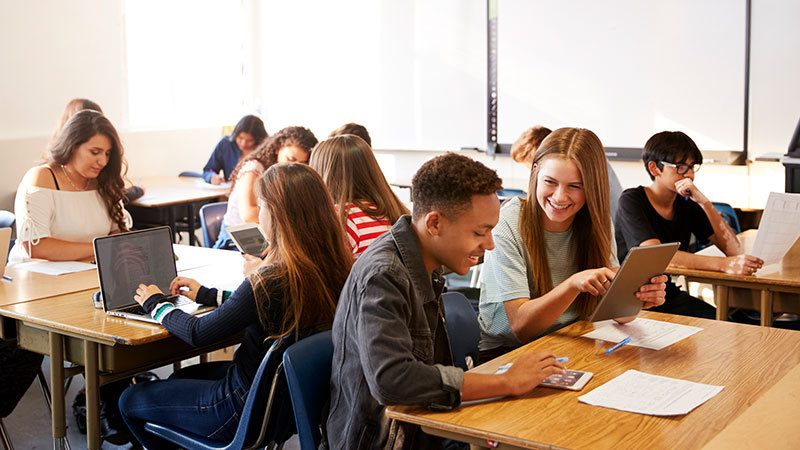No two students possess the same academic prowess. One student might go from shining to struggling when you switch from math to reading, and some students might excel in every class while others can’t seem to perform as well as their peers.
For many years, schools and teachers have tried to correct these differences in ability by grouping together students according to their strengths and performance. Despite helping in some respects, ability grouping has also proven to have harmful effects on students’ psyches and teachers’ already-limited bandwidth.
In this article, we’ll explore the advantages and disadvantages of ability grouping so you can decide whether the strategy will work in your classroom. We’ll also take a look at an alternative grouping strategy called cooperative learning.
An Overview of Ability Grouping
According to the National Education Association, ability grouping (also called tracking) is “the practice of grouping children together according to their talents in the classroom.” Unlike cooperative learning (which we’ll discuss later), ability grouping places students in homogenous groups or classrooms based on their academic abilities. For example, one group might be made up of the strongest-performing students, another might be made up of “average” students, and the last might be made up of struggling students.
There are two types of ability grouping:
- Within-class grouping: A teacher divides his or her students into small groups according to their grasp on a topic.
- Between-class grouping: In this top-down technique, a school evaluates students’ varying levels of academic achievement and places students into different classes or course sequences accordingly.
Ability Grouping: Pros and Cons
Even if you’ve never used ability grouping in your classroom, simply reading the definition probably brought to mind a host of ideas and potential problems. Following is a summary from Teachnology on the advantages and disadvantages of ability grouping, borne out by years of research on the topic.
Advantages
- A faster pace: Gifted students can sometimes grow bored or even act out when they finish their work or catch on to a concept much faster than their peers. However, in groups or classrooms that use ability grouping, gifted students can move at a faster pace along with their peers of the same ability level.
- More individualized attention: In mixed-ability classrooms, teachers must divide their time equally across students even if some students would benefit more from the teacher’s attention than others. But in classrooms that use ability grouping, teachers can more easily allocate their attention to the students who need it most and teach at a pace that works best for each group.
- Boosted confidence (for between-class grouping): In classes of students with mixed abilities, struggling students can sometimes develop harmful perceptions of themselves, such as being the “dumb kid” or the one who “always” gets the lowest grade on a test. However, in a between-class grouping, students are more likely to perform at the same levels, thus decreasing feelings of inadequacy or unhealthy competition.
Disadvantages
- Hurt feelings: Even when you use innocuous names for ability groups (e.g., “red group” and “blue group”), both younger and older students will often notice the disparities between groups. This can lead to hurtful jokes, name-calling, and social divisions that might not have otherwise arisen if not for the ability grouping.
- Unfair divisions: No matter what measurement you use, it’s inevitable that some students might end up in a group that doesn’t best fit their true capabilities. Whether they’re placed too high or too low, students can become demotivated quickly when they feel they are outperforming or underperforming their peers.
- Tainted teacher expectations: Even the most diligent teachers can sometimes subconsciously treat students differently based on their groups. If teachers unintentionally start lowering their expectations for struggling students, for example, those students might begin to feel like no one believes in them and perform at a lower level.
Cooperative Learning: The Next Evolution of Ability Grouping?
Because of the weaknesses and challenges of ability grouping, many teachers are turning to cooperative learning to help students work and learn together. Unlike ability grouping, which puts students of similar abilities together, cooperative learning groups together students of mixed abilities. For example, a group of four students might consist of one high-achieving student, two students of average ability or performance, and one struggling student.
According to Actively Learn, cooperative learning relies on the following principles to make it successful:
- All students benefit from collaboration and discussion. Research has repeatedly shown that working in groups results in higher academic achievement and improves students’ motivation, time on task, self-esteem, retention, and metacognition. When students have discussions, high achievers have an opportunity to elaborate on their thinking, while struggling students can ask their peers questions and seek clarification in a setting that is more relaxed and comfortable than asking a teacher a question in front of the whole class.
- All students enjoy and benefit from higher-order thinking. Struggling students are sometimes relegated to comprehension-check activities. However, open-ended questions are more interesting for students of all abilities and encourage them to discuss, debate, and actively construct knowledge rather than merely consuming information. In fact, higher-level questions can actually be easier for struggling students to approach because these questions offer more flexibility to explore the issue from multiple angles (rather than having to determine the one correct answer).
- Technology allows you to easily offer differentiated supports. Depending on the subject, some of your students may have knowledge gaps in vocabulary, historical references, or other background knowledge that keep them from comprehending an assignment as well as their peers. However, technology allows you to offer supports to fill those knowledge gaps. For example, when you use a tool like Google Classroom (or something similar), you can assign every student to read the same text and also assign additional resources for different students depending on their ability level. For example, you might ask struggling students to watch a video with important background knowledge or to look up key vocabulary terms, while high-achieving students might read another text that they can compare and contrast with the original text. Then, when students come together in cooperative learning groups, they will all have the same baseline knowledge to be able to work together on an assignment.
In her report on ability grouping vs. cooperative learning, Laura Martin notes that the strengths of cooperative learning can be considered a weakness as well. With cooperative learning, all students are responsible for each other’s learning, which can create a high sense of buy-in for the entire group, but that responsibility can become heavy for high-achieving students if teachers aren’t careful. As outlined above, both high-achieving and struggling students benefit from high-achieving students explaining or expanding on key concepts, but teachers need to be careful to ensure high-achieving students don’t feel abandoned or penalized if struggling students need more help than they can offer.






